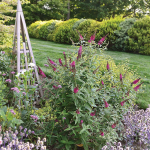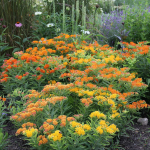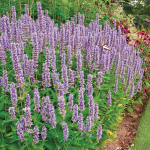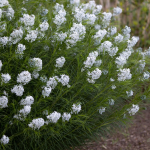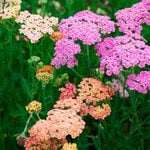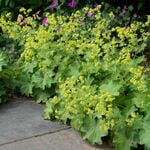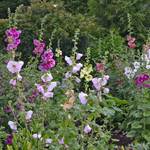Product Details
For about two weeks, beginning in mid-May, this lovely woodland plant produces large, pouchlike, golden yellow blooms on 18–24" stems above pleated apple green leaves. Contrary to received wisdom, it is not difficult to grow if it has evenly moist, humus-rich soil with a slightly acid to neutral pH and dappled shade. Once established, it may double in size on a yearly basis. For the serious woodland gardener, this is an opportunity that is not to be missed. This is perhaps the easiest of the Lady's Slipper Orchids to grow in a garden.
For more information on growing Cypripedium, click Growing Guide.
Shipping
HOW PLANTS ARE SHIPPED
The size of the plants we ship has been selected to reduce the shock of transplanting. For some, this means a large, bareroot crown. Others cannot travel bareroot or transplant best if grown in containers. We ship these perennials and annuals in 1 pint pots, except as noted. We must point out that many perennials will not bloom the first year after planting, but will the following year, amply rewarding your patience. We ship bulbs as dormant, bare bulbs, sometimes with some wood shavings or moss. Shrubs, Roses, vines, and other woody plants may be shipped bareroot or in pots. The size of the pot is noted in the quick facts for each item.
WHEN WE SHIP
We ship our bulbs and plants at the right time for planting in your area, except as noted, with orders dispatched on a first-come, first-served basis by climate zone. We also ship a wide range of containers and planters, tools, supplies, fertilizers, garden wear, garden decor items, as well as indoor decorations like wreaths and dried bouquets when available. Estimated dates for shipping are indicated in the green Shipping Details box for each item. Please supply a street address for delivery. Kindly contact us with two weeks notice, if you'll be away at the expected time of delivery.
OUR GUARANTEE
We guarantee to ship plants that are in prime condition for growing. If your order is damaged or fails to meet your expectations, we will cheerfully replace or refund it. Please contact our Customer Service Department at 1-800-503-9624 or email us at [email protected]. Please include your order number or customer number when contacting us.
Reviews
Growing guide
Latin Name Pronunciation: sip-prih-pee'dee-um
Our native Lady's Slipper Orchids are not difficult to grow if you follow the basic guidelines below. Please remember that these Orchids need to establish their root systems once planted, and no growth may appear above ground for some time (from 6–8 weeks to even a year).
Light needs. These Orchids are woodland plants that thrive in bright shade or dappled sunlight under tall trees. Try to simulate these conditions when choosing a site in your garden. The Orchid's exposure to direct sunlight should be limited to early morning or the end of the day, when the sun's rays are less intense. The exposure should not be for more than several hours. Keep in mind that plants will require more shade in the South than they will in the northern states.
Soil needs. Unlike some Orchids, these Lady's Slippers do not prefer an acid soil. They should be planted under deciduous trees such as maple, beech, ash, or oak, rather than pines or other needled evergreens.A soil pH range of 6.5 to 7.0 is best. Always have your soil tested before using any amendments to adjust pH. Your local USDA Cooperative Extension Service, listed in the government section of the telephone book, can give you information on soil testing. To raise soil pH, add pelletized lime (sold in garden centers), which is milder than ground limestone. Crushed oyster shell is also suitable and breaks down at a slow rate, keeping soil pH even. It is sold in farm or feed stores as chicken grit. Soils are less commonly too alkaline, but if tests show the pH is too high, apply decomposed pine needles or peat moss.
Water requirements. A uniform level of soil moisture is important for the health of the Orchid's roots—the soil should never be soggy, nor should it dry out. If your soil needs amending to ensure that it has this quality, we recommend adding leaf litter before you plant.Work in a 3–4in layer of decomposed leaves (collected beneath deciduous trees) for several square yards around the planting site. Leaves are sufficiently decomposed when they are dark and crumbly and you cannot recognize that they were indeed once leaves. Decomposed leaves add organic matter to the soil, which helps hold moisture but at the same time lightens the soil's texture, improving drainage. The result is soil that stays moist but is never water-logged.
If rain is not sufficient during the Orchid's period of active growth from spring until the leaves die back, you may need to supply water. If your water is chemically treated, allow it to sit for several days in an open container before using. Always check the amount of moisture in the soil before watering—the best instrument for this measurement is your finger. Feel the top 1in of soil. Unless it is dry, don't water. Young plants and plants coming out of dormancy use less water than larger or established plants do. Soil that is kept too wet cannot contain enough oxygen for roots. The result is root rot and even plant death.
Planting. Dig a hole large enough to accommodate the roots of your bareroot Orchid. Hold the tip of the bullet-shaped bud so that it faces up and is ¼–½in below the soil line, and gently fill in around the roots and over the top of the bud with soil.Water thoroughly. Do not fertilize right after planting.
Mulch and winter protection. A 2–3in layer of chopped leaves from deciduous trees makes an ideal top dressing of mulch around your Orchid after planting. Simply run a lawnmower (with a catch bag attached) through a pile of fallen leaves.After the ground is cold in the fall, use a 6in layer of chopped leaves as winter protection to prevent the soil from frost heaving. In spring when the Orchid's leaves start to appear, simply push away the chopped leaves nearest to the plant.
Fertilizer. Only apply fertilizer when your Orchid is in active growth.We recommend using a balanced fertilizer, such as Peter's 20–20–20 (which also contains micronutrients), or an organic formulation (fish and kelp emulsion is widely available). Dilute a concentrated fertilizer such as Peter's to ¼ strength.Apply the diluted fertilizer when new growth first emerges and then every 1–2 weeks until flowering has finished. If your plant does not flower the first year, stop fertilizing by the end of June.
Pests and disease. A strong, healthy plant has a better chance of shrugging off minor nibbling or chewing. Meeting a plant's cultural needs is therefore the best defense against pests and disease. If you have serious problems with slugs, mites, leafminers, or other pests, please call our Garden Advisors for suggestions on treatment. If you have questions that this guide does not cover, call our Garden Advisors at (860) 482-8915 from 9 to 4:30 Eastern time, Monday through Friday.

 (1 Review)
(1 Review)

